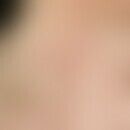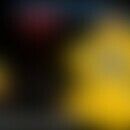Synonym(s)
DefinitionThis section has been translated automatically.
The Alagille syndrome is a very rare, autosomal dominant hereditary disease. There are 2 known subforms:
- ALGS1: mutation in the JAG1 gene (chromosome 20p12.2)
- ALGS2: Mutation in the NOTCH2 gene (chromosome 1p13-p11)
The following symptoms define the Agille syndrome:
- Cholestasis due to the rarefaction of the intrahepatic bile ducts
- and the skeleton (butterfly vertebrae, short distal phalanges, clinodactyly, shortened ulna)
- Heart diseases (pulmonary artery stenoses + other heart vitae).
- Skeletal anomalies
- Eye abnormalities (embryotoxon, drusen on the optic nerve)
- Characteristic facial phenotype (broad forehead, deep-set eyes, hypertelorism, narrow chin; Li et al. 1997).
- About 39% of patients also have kidney involvement, mainly renal dysfunction (Kamath et al., 2012).
Occurrence/EpidemiologyThis section has been translated automatically.
The prevalence is estimated at 1: 70,000 to 1:100,000.
You might also be interested in
ClinicThis section has been translated automatically.
In addition to the neonatal icterus, the characteristics of this syndrome include the following: in the eye, changes in the posterior embryotoxin and retinal pigments; in the heart, pulmonary valve stenosis and peripheral arterial stenosis; in the bones, abnormal vertebrae (butterfly vertebrae) and reduction of the interpedicular distance in the lumbar spine; lack of deep tendon reflexes in the nervous system and poor academic performance; in the facies broad forehead, pointed lower jaw and bulbous tip of the nose and in the fingers different degrees of shortening (Watson and Miller 1973; Alagille et al. 1975; Rosenfield et al. 1980).
HistologyThis section has been translated automatically.
Histology of the liver shows a significant reduction of intrahepatic bile ducts.
Case report(s)This section has been translated automatically.
Shulman et al (1984) describe a family with 5 affected persons in 3 generations. The degree of severity varied greatly. Two sisters had neonatal icterus, peripheral pulmonary stenosis and characteristic facies such as broad forehead, deep-set eyes, protruding nose and pointed chin. One patient died at the age of 5 years of cirrhosis of the liver with portal hypertension. The second affected person died of heart failure at the age of 18 months. Her asymptomatic mother and an aunt had a similar facial appearance, pulmonary stenosis and skeletal anomalies.
LiteratureThis section has been translated automatically.
- Alagille D et al (1987) Syndromic paucity of interlobular bile ducts (Alagille syndrome or arteriohepatic dysplasia): review of 80 cases. J. Pediat. 110: 195-200
- Alagille D et al (q1975) Hepatic ductular hypoplasia associated with characteristic facies, vertebral malformations, retarded physical, mental and sexual development, and cardiac murmur. J. Pediat. 86: 63-71
- Kamath B et al (2002) Craniosynostosis in Alagille syndrome. Am. J. Med. Genet. 112: 176-180
- Li L et al (q1997) Alagille syndrome is caused by mutations in human Jagged1, which encodes a ligand for Notch1. Nature Genet 16: 243-251
- Li P et al (1996) Alagille syndrome with interstitial 20p deletion derived from maternal ins(7;20). Am. J Med Genet 63: 537-541
- Rosenfield N S et al (1980) Arteriohepatic dysplasia: radiologic features of a new syndrome. Am. J. Roentgen. 135: 1217-1223
- Shulman S A et al (1984) Arteriohepatic dysplasia (Alagille syndrome): extreme variability among affected family members. At J Med Genet 19: 325-332
- Watson G H et al (1973) Arteriohepatic dysplasia: familial pulmonary arterial stenosis with neonatal liver disease. Arch Dis Child 48: 459-466
Outgoing links (1)
Hypertelorism;Disclaimer
Please ask your physician for a reliable diagnosis. This website is only meant as a reference.




